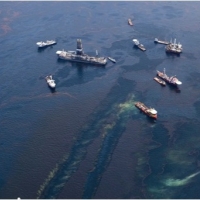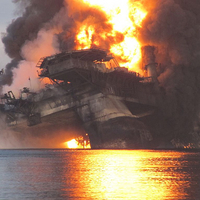By Gail Riekie. 27th May 2010.
Most readers will be familiar with the notion of ‘six degrees of separation’. The idea that, by linking ‘a friend of a friend of a friend’, no person is more than six steps away from any other human being on the planet. What started out as an academic theory about networks eventually morphed into the parlour game most commonly associated with the Hollywood actor Kevin Bacon.
Scouring the news and the scientific literature for stories about methane these last few months, I can’t help but be struck by how this small gas molecule seeps into so many different aspects of our life. Take any area of human endeavour or issue relating to the environment, and I’d wager that you could find a connection to methane in far fewer than six steps. (A game to play at a future MethaneNet meeting, perhaps?)
Take the recent terrible news from the Gulf of Mexico (see also the news item on this website). A series of explosions on an exploration drilling rig killed eleven men and wrecked a massive drilling rig. Weeks later, oil and gas are still gushing out of the well and polluting the ocean. No-one yet knows exactly what failures led to the gas explosions, nor what volume of hydrocarbon has already leaked, nor where it will end up. BP, the owner of the well, is attempting a range of strategies to contain the leak and to mitigate the effects of the oil already spilt.
You can find a ‘methane’ angle to just about every aspect of this tragedy. The lethal explosions were triggered by a gas (predominantly methane, of course) surge which the blow-out preventers failed to contain. BP’s attempts to gather up the leaking oil into a seabed container were foiled because methane hydrates clogged up the cofferdam which could not then be deployed. Methane hydrates are a known hazard to drilling in many areas of the Gulf of Mexico, including where the well was drilled. The issue of how heat from certain drilling operations (e.g. the cementing process) has potential to destabilise hydrates and release methane may not be directly relevant to the Deepwater Horizon disaster but has drawn attention anyway to the issue of warmer conditions precipitating methane release, and so forges a link to the issue of climate change and methane as a greenhouse gas. In this week’s issue of Nature (1), David Valentine has proposed that measuring methane concentrations associated with the leaking well could help provide more accurate information about the overall volume of the oil now drifting around the Gulf of Mexico. To do so would require knowledge of, amongst other things, methane transport pathways and estimates of rates of microbial methane oxidation in the seawater column. Furthermore, the ecology of wetlands in Florida and Louisiana are threatened if the oil reaches the coast. Wetlands are the biggest single natural source of methane to the atmosphere. The impact of the oil slick on methanogenesis in these areas is another unknown. Finally, in terms of energy policy, as a result of the disaster the future of offshore drilling for oil and gas in the US hangs in the balance. One could speculate that this in turn may drive efforts to produce gas from ‘non-conventional’ methane sources such as coal bed methane, agricultural waste and landfill.
MethaneNet aims to facilitate communication between methane researchers and other stakeholders of all shapes and sizes, answering a perceived need for better co-ordination. Sometimes it is only when you step back to look at the big picture that the connections between different aspects of research become apparent, as I hope I have demonstrated with this topical example.
As Methane Network Co-ordinator, I want users of this MethaneNet.org website to make full use of all the networking facilities it offers and in doing so to gain new and productive insights into their own work. If you have any suggestions for encouraging active participation in this project, please do leave a comment.
(1) Valentine,D (2010) Measure methane to quantify the oil spill, Nature 465, 421, doi:10.1038/465421a


